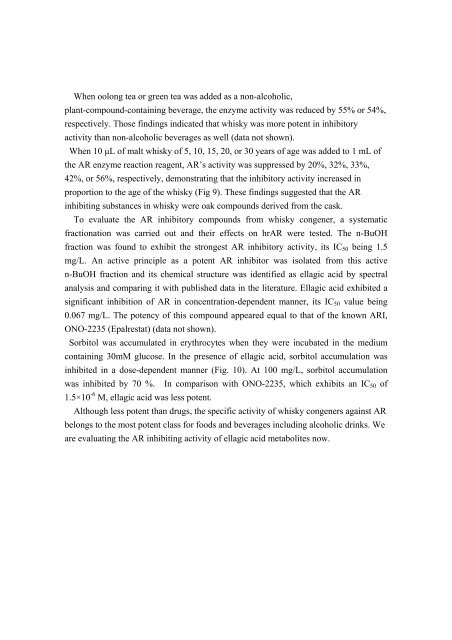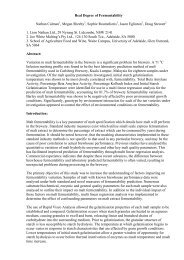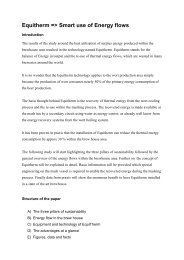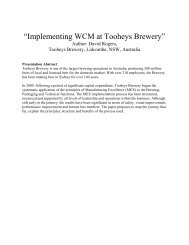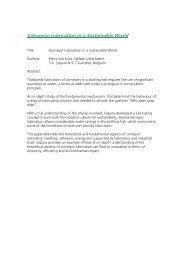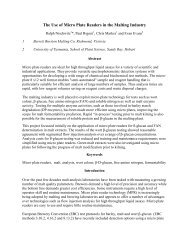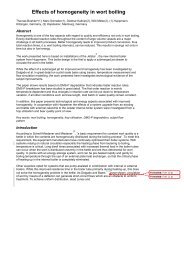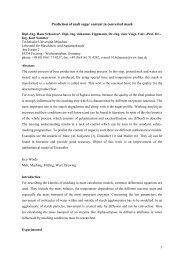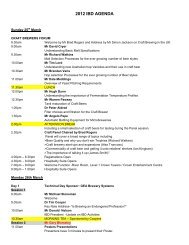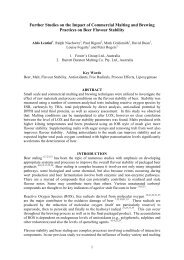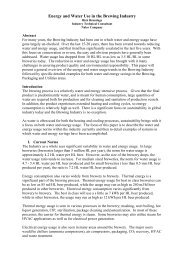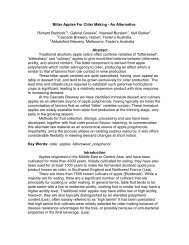Influence of Whisky Congeners on Health - The Institute of Brewing ...
Influence of Whisky Congeners on Health - The Institute of Brewing ...
Influence of Whisky Congeners on Health - The Institute of Brewing ...
Create successful ePaper yourself
Turn your PDF publications into a flip-book with our unique Google optimized e-Paper software.
When ool<strong>on</strong>g tea or green tea was added as a n<strong>on</strong>-alcoholic,<br />
plant-compound-c<strong>on</strong>taining beverage, the enzyme activity was reduced by 55% or 54%,<br />
respectively. Those findings indicated that whisky was more potent in inhibitory<br />
activity than n<strong>on</strong>-alcoholic beverages as well (data not shown).<br />
When 10 μL <str<strong>on</strong>g>of</str<strong>on</strong>g> malt whisky <str<strong>on</strong>g>of</str<strong>on</strong>g> 5, 10, 15, 20, or 30 years <str<strong>on</strong>g>of</str<strong>on</strong>g> age was added to 1 mL <str<strong>on</strong>g>of</str<strong>on</strong>g><br />
the AR enzyme reacti<strong>on</strong> reagent, AR’s activity was suppressed by 20%, 32%, 33%,<br />
42%, or 56%, respectively, dem<strong>on</strong>strating that the inhibitory activity increased in<br />
proporti<strong>on</strong> to the age <str<strong>on</strong>g>of</str<strong>on</strong>g> the whisky (Fig 9). <strong>The</strong>se findings suggested that the AR<br />
inhibiting substances in whisky were oak compounds derived from the cask.<br />
To evaluate the AR inhibitory compounds from whisky c<strong>on</strong>gener, a systematic<br />
fracti<strong>on</strong>ati<strong>on</strong> was carried out and their effects <strong>on</strong> hrAR were tested. <strong>The</strong> n-BuOH<br />
fracti<strong>on</strong> was found to exhibit the str<strong>on</strong>gest AR inhibitory activity, its IC50 being 1.5<br />
mg/L. An active principle as a potent AR inhibitor was isolated from this active<br />
n-BuOH fracti<strong>on</strong> and its chemical structure was identified as ellagic acid by spectral<br />
analysis and comparing it with published data in the literature. Ellagic acid exhibited a<br />
significant inhibiti<strong>on</strong> <str<strong>on</strong>g>of</str<strong>on</strong>g> AR in c<strong>on</strong>centrati<strong>on</strong>-dependent manner, its IC50 value being<br />
0.067 mg/L. <strong>The</strong> potency <str<strong>on</strong>g>of</str<strong>on</strong>g> this compound appeared equal to that <str<strong>on</strong>g>of</str<strong>on</strong>g> the known ARI,<br />
ONO-2235 (Epalrestat) (data not shown).<br />
Sorbitol was accumulated in erythrocytes when they were incubated in the medium<br />
c<strong>on</strong>taining 30mM glucose. In the presence <str<strong>on</strong>g>of</str<strong>on</strong>g> ellagic acid, sorbitol accumulati<strong>on</strong> was<br />
inhibited in a dose-dependent manner (Fig. 10). At 100 mg/L, sorbitol accumulati<strong>on</strong><br />
was inhibited by 70 %. In comparis<strong>on</strong> with ONO-2235, which exhibits an IC50 <str<strong>on</strong>g>of</str<strong>on</strong>g><br />
1.5×10 -6 M, ellagic acid was less potent.<br />
Although less potent than drugs, the specific activity <str<strong>on</strong>g>of</str<strong>on</strong>g> whisky c<strong>on</strong>geners against AR<br />
bel<strong>on</strong>gs to the most potent class for foods and beverages including alcoholic drinks. We<br />
are evaluating the AR inhibiting activity <str<strong>on</strong>g>of</str<strong>on</strong>g> ellagic acid metabolites now.


